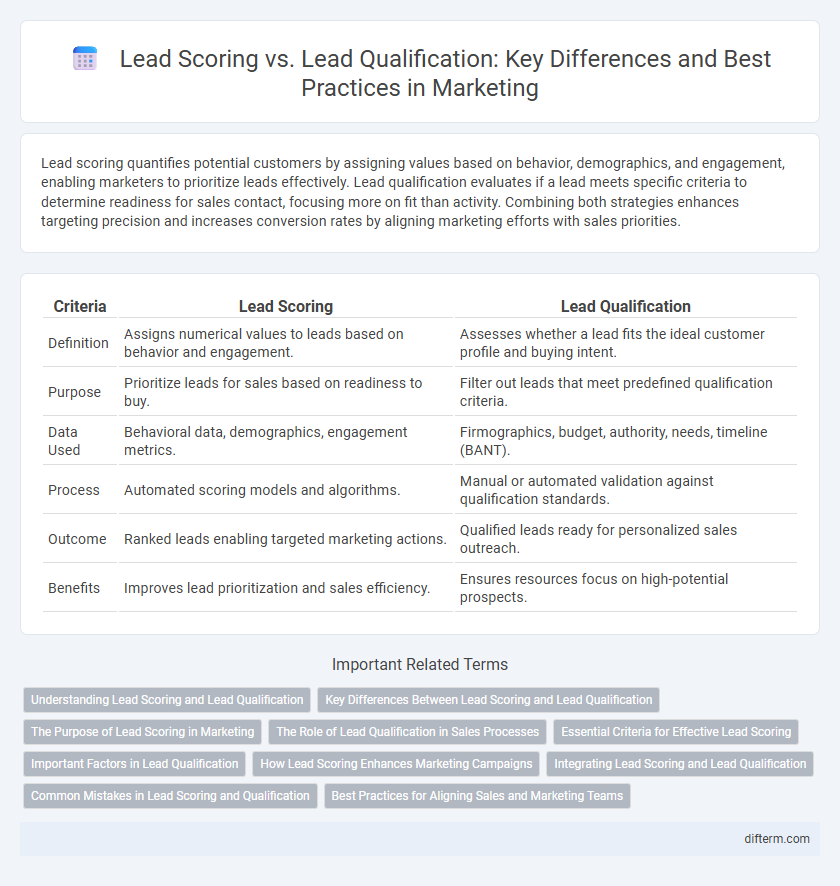Lead scoring quantifies potential customers by assigning values based on behavior, demographics, and engagement, enabling marketers to prioritize leads effectively. Lead qualification evaluates if a lead meets specific criteria to determine readiness for sales contact, focusing more on fit than activity. Combining both strategies enhances targeting precision and increases conversion rates by aligning marketing efforts with sales priorities.
Table of Comparison
| Criteria | Lead Scoring | Lead Qualification |
|---|---|---|
| Definition | Assigns numerical values to leads based on behavior and engagement. | Assesses whether a lead fits the ideal customer profile and buying intent. |
| Purpose | Prioritize leads for sales based on readiness to buy. | Filter out leads that meet predefined qualification criteria. |
| Data Used | Behavioral data, demographics, engagement metrics. | Firmographics, budget, authority, needs, timeline (BANT). |
| Process | Automated scoring models and algorithms. | Manual or automated validation against qualification standards. |
| Outcome | Ranked leads enabling targeted marketing actions. | Qualified leads ready for personalized sales outreach. |
| Benefits | Improves lead prioritization and sales efficiency. | Ensures resources focus on high-potential prospects. |
Understanding Lead Scoring and Lead Qualification
Lead scoring quantifies a prospect's engagement and fit using data points such as demographics, behavior, and interaction history to prioritize leads systematically. Lead qualification involves evaluating if a lead meets predefined criteria related to budget, authority, need, and timeline, ensuring alignment with ideal customer profiles. Understanding the distinction allows marketers to optimize sales efforts by targeting high-potential prospects and improving conversion rates effectively.
Key Differences Between Lead Scoring and Lead Qualification
Lead scoring quantifies leads by assigning values based on engagement, demographics, and behavior patterns, providing a numerical indication of lead quality. Lead qualification evaluates whether leads meet predefined criteria aligning with ideal customer profiles, focusing on fit and readiness to buy. The key difference lies in lead scoring's data-driven prioritization versus lead qualification's criteria-based assessment for sales readiness.
The Purpose of Lead Scoring in Marketing
Lead scoring in marketing serves to quantify the engagement level and potential value of leads by assigning numerical values based on their behaviors and attributes, enabling sales teams to prioritize high-quality prospects efficiently. It improves resource allocation by identifying leads most likely to convert, enhancing campaign effectiveness and accelerating the sales cycle. Unlike lead qualification, which categorizes leads as fit or unfit, lead scoring provides a dynamic, data-driven approach to continuously measure lead readiness.
The Role of Lead Qualification in Sales Processes
Lead qualification plays a critical role in sales processes by identifying prospects most likely to convert, ensuring sales teams focus efforts on high-potential leads. Unlike lead scoring, which assigns numeric values based on engagement and demographics, lead qualification involves a deeper assessment of a prospect's needs, budget, authority, and timeline. This targeted approach accelerates sales cycles and improves conversion rates by aligning marketing efforts with sales-ready opportunities.
Essential Criteria for Effective Lead Scoring
Effective lead scoring hinges on identifying essential criteria such as demographic data, engagement levels, and purchasing intent to accurately prioritize prospects. Incorporating behavioral signals like website activity, email interactions, and social media engagement enhances scoring precision. Precise lead scoring aligns marketing efforts with sales readiness, maximizing conversion rates and optimizing resource allocation.
Important Factors in Lead Qualification
Lead qualification hinges on critical factors such as budget, decision-making authority, and timeline, which determine a prospect's readiness to purchase. Evaluating a lead's fit based on demographic, firmographic, and behavioral data ensures alignment with ideal customer profiles. These qualifying criteria prioritize high-potential leads, optimizing sales efficiency and conversion rates in marketing strategies.
How Lead Scoring Enhances Marketing Campaigns
Lead scoring enhances marketing campaigns by assigning quantitative values to leads based on their behaviors, demographics, and engagement levels, allowing marketers to prioritize high-potential prospects. This data-driven approach enables targeted messaging and resource allocation, increasing conversion rates and campaign efficiency. Unlike lead qualification, which is often a binary assessment, lead scoring provides a nuanced view of lead quality that supports dynamic campaign optimization.
Integrating Lead Scoring and Lead Qualification
Integrating lead scoring and lead qualification enhances marketing efficiency by combining quantitative data with qualitative insights to prioritize prospects most likely to convert. Lead scoring uses behavioral and demographic metrics to assign values, while lead qualification applies specific criteria to assess readiness and fit. This integrated approach streamlines sales efforts, improves targeting accuracy, and accelerates the conversion process.
Common Mistakes in Lead Scoring and Qualification
Common mistakes in lead scoring and qualification include relying too heavily on demographic data without considering behavioral signals, leading to inaccurate prioritization of prospects. Failing to update scoring criteria regularly results in outdated profiles that do not reflect current buyer intent or market conditions. Overlooking collaboration between marketing and sales teams can cause misalignment in defining qualified leads, reducing conversion rates and overall campaign effectiveness.
Best Practices for Aligning Sales and Marketing Teams
Effective lead scoring involves assigning numerical values to leads based on demographic data and behavioral signals, enabling precise prioritization that aligns marketing efforts with sales goals. Lead qualification requires collaborative criteria establishment between sales and marketing teams to ensure leads are not only engaged but also fit the ideal customer profile, increasing conversion rates. Regular cross-functional meetings and shared CRM platforms foster transparency, ensuring both teams maintain consistent definitions and processes for lead evaluation and handoff.
Lead Scoring vs Lead Qualification Infographic

 difterm.com
difterm.com